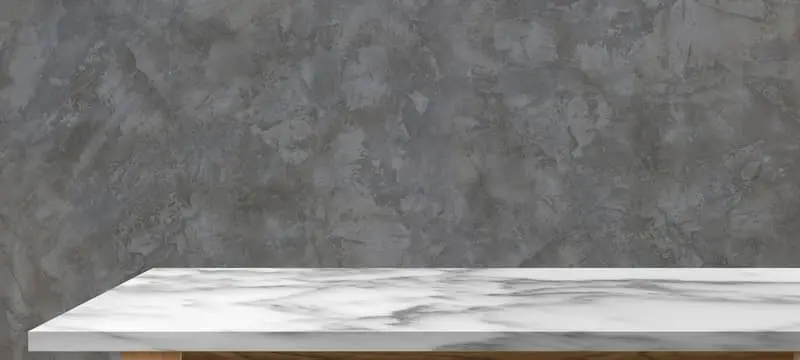It is a unique time for homeowners to explore countertop options.
There is a growing preference for natural countertop materials, as homeowners seek sustainable, stylish options to furnish and decorate their homes.
Meanwhile, recent health data has revealed a link between silicosis (a life-altering, incurable respiratory disease), and the manufacturing and fabrication of engineered stone without proper safety measures in place. These studies have resulted in new regulations and scrutiny around engineered stone.
As these influences push the trend cycle, homeowners are weighing their options with natural materials, eager to learn more about care and management, alongside much-loved engineered stone, which remains by far the most popular.
Countertop trendlines
It’s not surprising that engineered stone is so popular. Homeowners hold it as a standard for style and quartz ticks all the boxes for price, durability, longevity and aesthetic qualities that the mass market knows and loves.
But, with new focus on the backstory behind quartz countertop fabrication, and fresh style inspiration offered with other materials, the timing for trend evolution is telling.
Christopher Grubb of Arch-Interiors Design Group Inc notes that more homeowners are becoming curious about natural stone, for example, and what’s involved.
Beyond reacting to the recent regulatory stance around engineered stone, “I think part of a shift away from quartz is a style progression. A natural stylistic transition,” says Grubb, citing how past mass-market trends, such as stainless-steel appliances in the kitchen were quickly adopted as a standard for style, and eventually homeowners expanded their aesthetic, because that is what occurs organically as trends evolve.
Cost may be a factor here too, given enhanced safety measures recently introduced around engineered stone. While pricing has been one of the more attractive features of quartz, it is logical to assume that prices may rise to account for additional machinery, labor and infrastructure to comply with new regulations, so forward-thinking designers and design enthusiasts are exploring options.
As with all design choices, particularly those that may hover outside of the comfort zone, homeowners should adopt an education-first approach that compares pros and cons for materials, applied through the lens of function and style.

For example, there is a perception that natural stones, such as quartzite, granite or marble are onerous and delicate.
Not so, according to Grubb.
“With natural stones that I have done over 30 years, I’ve never once ever had somebody complain about the materials in kitchen or the bathroom. Never,” he says.
The key, he says, is to adopt a maintenance plan at the outset.
“Every couple of years, you clean it and seal it again. And it’s not an enormous process,” he says.
He uses the analogy of owning a polyester shirt versus owning a silk shirt. The expectation around care is different, but so is the look, feel and style statement with the product in regular use.
Grubb encourages homeowners to create a comfort level with potential material choices by getting hands on, asking lots of questions and looking for advice from trusted professionals.
“Get samples. Put liquids on them. Test it out and do what you need to do to actually get that level of comfort,” he says.
For specific stones, find professionals who have worked with them in the past and solicit feedback on the material’s performance over time.
A lot of the joy in working with natural stone comes from embracing the creative opportunity of a unique aesthetic. Part of the appeal of engineered stone is its wide availability thanks to mass production. But mass production is also synonymous with ubiquitous, while natural stone offers a one-of-a-kind experience, often with Mother Nature as your designer.
“I think one of the bonuses of natural stone is the adventure in choosing a stone that is special,” says Grubb.
Heart set on quartz? Ask the right questions
And if your heart is set on engineered stone, homeowners may be able to satisfy their concerns simply by asking more questions during their selection process.
“If the consumer really wants quartz, they should ask the fabricator about their methods. That’s really important,” says Grubb.
“Ask about ventilation and the methodology that stones are being prepared with. Look for proof that the fabricator is protected,” he says.
Popular alternatives to quartz
Weighing the options? Here are some of the most popular alternatives to quartz:
Quartzite
Although its name resembles quartz, quartzite is a naturally occurring metamorphic rock that features some stunning veining patterns. It looks a lot like marble but is less expensive.
It’s one of the most popular counter materials, behind quartz. However, homeowners should know that, depending on the slab, quartzite potentially has a very high silica content, compared to some other natural stones.
With proper care from the homeowner, quartzite is very durable and long-lasting. It is heat resistant to a degree, but homeowners should put pads underneath hot pots and dishes.
Marble
Marble counters are luxe and rich, with visual texture and a variety of colors and patterns. Like other natural stone, it is heavy to install. It’s also quite pricey, so homeowners should budget accordingly.
Marble can be used beautifully on lots of surfaces, including flooring. Properly sealing and coating will keep marble floors from being slippery.
Homeowners that bake often like marble because it is naturally cool material, good for keeping ingredients such as butter in the proper state when working on the countertop.
Limestone
“Limestone is more porous,” says Grubb, so that is a consideration, as it may be more susceptible to scratching and staining.
But there is no denying its subtle beauty with patterning derived from natural materials, such as stones, fossils and shells.
“We’ve been using it a lot as an accent on a kitchen island,” says Grubb.
Soapstone
“Soapstone is more limited in color choices, but chefs like it,” says Grubb, as soapstone is easy to clean and sanitize.
It’s also heat resistant and bears a lovely patina as it ages. While it may not provide the dynamic patterning that some of the other natural stones offer, the soft neutrality makes it timeless.
Granite
Granite was quartz’s predecessor in mass-market countertop appeal, and it has proved its staying power, thanks to durability and visual texture. However, the heavier aesthetic isn’t necessarily suited for all housing styles.
But where the style allows, it can be stunning and meaningful. Think countryside or mountain home.
If properly treated, sealed and maintained, granite is a kitchen workhorse, able to withstand heat and is scratch resistant.
Wood
The warmth of wood is welcome in the kitchen, which is typically filled with hard and cold surfaces. Butcher block counters are trending, especially for homeowners looking to blend materials.
However, wood can be challenging from a use standpoint, as it is notoriously hard to keep clean and can suffer water damage if not properly sealed, especially important if the countertop is near a sink.
If thinking about wood as an option, marine-grade wood has an exotic aesthetic, and stands up better to moisture.








